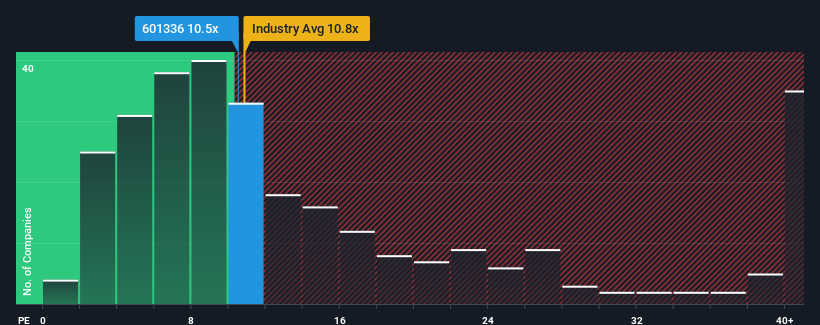Insufficient Growth At New China Life Insurance Company Ltd. (SHSE:601336) Hampers Share Price

New China Life Insurance Company Ltd.'s (SHSE:601336) price-to-earnings (or "P/E") ratio of 10.5x might make it look like a strong buy right now compared to the market in China, where around half of the companies have P/E ratios above 28x and even P/E's above 52x are quite common. Nonetheless, we'd need to dig a little deeper to determine if there is a rational basis for the highly reduced P/E.
New China Life Insurance has been struggling lately as its earnings have declined faster than most other companies. The P/E is probably low because investors think this poor earnings performance isn't going to improve at all. You'd much rather the company wasn't bleeding earnings if you still believe in the business. If not, then existing shareholders will probably struggle to get excited about the future direction of the share price.
View our latest analysis for New China Life Insurance

Does Growth Match The Low P/E?
There's an inherent assumption that a company should far underperform the market for P/E ratios like New China Life Insurance's to be considered reasonable.
Retrospectively, the last year delivered a frustrating 56% decrease to the company's bottom line. As a result, earnings from three years ago have also fallen 41% overall. Therefore, it's fair to say the earnings growth recently has been undesirable for the company.
Shifting to the future, estimates from the nine analysts covering the company suggest earnings should grow by 9.3% per year over the next three years. That's shaping up to be materially lower than the 23% per year growth forecast for the broader market.
In light of this, it's understandable that New China Life Insurance's P/E sits below the majority of other companies. It seems most investors are expecting to see limited future growth and are only willing to pay a reduced amount for the stock.
The Final Word
Using the price-to-earnings ratio alone to determine if you should sell your stock isn't sensible, however it can be a practical guide to the company's future prospects.
We've established that New China Life Insurance maintains its low P/E on the weakness of its forecast growth being lower than the wider market, as expected. At this stage investors feel the potential for an improvement in earnings isn't great enough to justify a higher P/E ratio. Unless these conditions improve, they will continue to form a barrier for the share price around these levels.
And what about other risks? Every company has them, and we've spotted 2 warning signs for New China Life Insurance you should know about.
You might be able to find a better investment than New China Life Insurance. If you want a selection of possible candidates, check out this free list of interesting companies that trade on a low P/E (but have proven they can grow earnings).
If you're looking to trade New China Life Insurance, open an account with the lowest-cost platform trusted by professionals, Interactive Brokers.
With clients in over 200 countries and territories, and access to 160 markets, IBKR lets you trade stocks, options, futures, forex, bonds and funds from a single integrated account.
Enjoy no hidden fees, no account minimums, and FX conversion rates as low as 0.03%, far better than what most brokers offer.
Sponsored ContentValuation is complex, but we're here to simplify it.
Discover if New China Life Insurance might be undervalued or overvalued with our detailed analysis, featuring fair value estimates, potential risks, dividends, insider trades, and its financial condition.
Access Free AnalysisHave feedback on this article? Concerned about the content? Get in touch with us directly. Alternatively, email editorial-team (at) simplywallst.com.
This article by Simply Wall St is general in nature. We provide commentary based on historical data and analyst forecasts only using an unbiased methodology and our articles are not intended to be financial advice. It does not constitute a recommendation to buy or sell any stock, and does not take account of your objectives, or your financial situation. We aim to bring you long-term focused analysis driven by fundamental data. Note that our analysis may not factor in the latest price-sensitive company announcements or qualitative material. Simply Wall St has no position in any stocks mentioned.
About SHSE:601336
New China Life Insurance
Provides life insurance products and services to individuals and institutions in China.
Solid track record established dividend payer.
Similar Companies
Market Insights
Community Narratives



